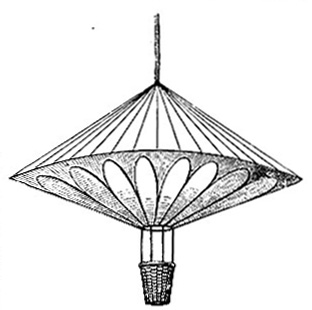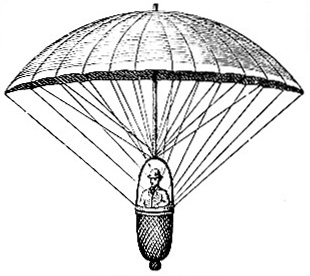1902 Encyclopedia > Aeronautics > Fatal Parachute Descent of Cocking. Narrow Escape of Green and Spencer. Mr Hampton's Parachute Descents. Descending Balloon Takes the Parachute Form.
Aeronautics
(Part 40)
Fatal Parachute Descent of Cocking. Narrow Escape of Green and Spencer. Mr Hampton's Parachute Descents. Descending Balloon Takes the Parachute Form.
The next experiment made with a parachute was that which resulted in the unfortunate death of Mr. Robert Cocking. So early as 1814 this gentleman had lectured on the subject before the City Philosophical Society, and also before the Society of Arts. He always retained an interest in ballooning, and made two ascents -- one with Mr, Sadler, and the other on September 27, 1836, with Mr. Green. The success of the balloon trip of Messrs Hollond, Mason, and Green, seems to have incited Mr. Cocking to demonstrate practically the truth of his views.
He accordingly constructed a suitable parachute on his principles, and having succeeded in obtaining the consent of Messrs Hughes and Gye, the proprietors of Vauxhall Gardens, to permit the ascent to be made there, he prevailed on Mr. Green to ascend in his great Nassau balloons with the parachute attached.
The great defect of Garnerin's umbrella-shaped parachute was its violent oscillation during descent, and Mr. Cocking considered that if the parachute were made of a conical (vertex downwards), the whole of this oscillation would be avoided; and if it were made of sufficient size, there would be resistance enough to check too rapid a descent. He therefore constructed a parachute on this principle, the radius of which at is widest part was about 17 feet, it was stated in the public announcement previous to the experiment that the whole weighted 223 lb; but from the evidence at the inquest it appeared that the weight must have been over 400 lb. Mr. Cocking's weight was 177 lb., which was so much additional.

Cocking's Parachute
On July 24, 1837, the trial took place; and the Nassau balloon, with Mr. Green and Mr. Spencer, a solicitor, in the car, and having suspended below it the parachute, in the car of which was Mr. Cocking, rose from the ground at twenty-five minutes to eight in the evening. A good deal of difficulty was experienced in rising to a suitable height, partly in consequence of the resistance to the air offered by the expanded parachute, and partly owing to its weight. Mr. Cocking wished the height to be 8000 feet; but when the balloon reached the height of 5000 feet, it being then nearly over Greenwich, Mr. Green called out to Mr. Cocking that he should be unable to ascend to the requisite height if the parachute was to descend in daylight. Mr. Cocking accordingly let ship the catch which was to liberate him from the balloon. The parachute for a few seconds descended very rapidly but still evenly, until suddenly the upper rim seemed to give way, and the whole apparatus collapsed (taking a form resembling an umbrella turned inside out, and nearly closed), and the machine descended with great rapidity; oscillating very much. When about two or three hundred feet from the ground, the basket became disengaged from the remnant of the parachute, and Mr. Cocking was found in a field at Lee, literally dashed to pieces.
Mr. Green and Mr. Spencer, who were in the car of the balloon, had also a narrow escape. At the moment the parachute was disengaged they crouched down in the car, and Mr. Gren clung to the valve-line, to permit the escape of the gas. The balloon shot upwards, plunging and rolling, and the gas pouring both the upper and lower valves, but chiefly from the latter, as the great resistance of the air checked its egress from the former. Mr. Green and Mr. Spencer applied their mouths to tubes communicating with an air bag with which they had had the foresight to provide themselves, otherwise they would certainly have been suffocated by the gas. Notwithstanding his precaution, however, the gas almost totally deprived them of sight for four or five minutes. When the came to themselves they found they were at a height of about four miles, and descending rapidly. They effected, however, a safe descent near Maidstone.
Many objections were made, after the result, to the form of Mr. Cocking's parachute; but there is little doubt that had it been constructed of sufficient strength, and perhaps of somewhat larger size, it would have answered its purpose.. as it was, the upper rim was made of tin, which soon gave way. Mr. Wise, the American aeronaut, made some experiments on parachutes of both forms (Garnerin's and Cocking's), and found that the latter always were much more steady, descending generally in a spiral curve.

Hampton's Parachute
In 1839 Mr. Hampton made three descents in a parachute, on Garnerin's pattern, from his balloon, the "Albion." He followed Garnerin's example in attaching the parachute to the netting of the balloon, so that when between the two was severed the latter was left to its own devices. Mr. Hampton took measures, however, that it should descend soon after the parachute, and it was generally found no great distance off, and returned to him. All his parachute descents were safely performed, although in one he was a good deal shaken.
We may remark that a descending balloon half-full of has either does rise, or can with a little management be made to rise, to the top of the netting and take the form of a parachute, thus materially lessening the rapidity of descent. Mr. Wise, in fact, having noticed this, once purposely exploded his balloon when at a considerable the altitude, and the resistance offered to the air by the envelope of the balloon was sufficient to enable him to reach the ground without injury. And a similar thing took place in one of Mr. Glaisher's high scientific ascent (April 18, 1863), when, at a height of about 2 miles, the sea appeared directly, underneath; the gas was let out of the balloon as quickly as possible, and the velocity of descent was so great, that the 2 miles of vertical height were passed through in four minutes. On the balloon reaching the ground at Newhaven, close to the shore, it was found to be nearly empty. The balloon had, in fact, for the last mile or more, merely acted as a parachute; the shock was a severe one, and all the instrument were broken, but nothing serious resulted to the occupants of the car.
Read the rest of this article:
Aeronautics - Table of Contents
|

